CR1220 Battery Equivalents and Replacements
CR1220 battery is a very popular non-rechargeable lithium 3.0V button/coin cell battery commonly used in keychain LED flashlights, thermometers, keyless remotes, medical scales, PDAs, heart rate monitors, cameras, calculators, and other electronic equipment.
CR1220 batteries are much more common than BR1220 batteries - they share the same physical dimensions, but they differ in chemistry and thus have different characteristics in terms of battery capacity, voltage, operating temperature, self-discharge rate, etc.
Updated: March 20, 2024.
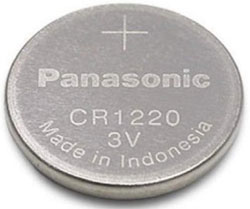
|
Shop for CR1220 battery? Some of the most popular models include (Amazon links, the links open in the new windows): |
CR1220 Batteries Features and Specifications
CR1220 and BR1220 batteries feature the same physical dimensions of (D x H) 12.5 x 2.0 mm (~0.4921 x 0.07874 inches).
While CR1220 and BR1220 are the most common labels for lithium 3.0 volts non-rechargeable button/coin cell batteries, other labels are used as well, including ECR1220, DL1220, VR1220, 5012LC, etc.
These are all button/coin 12.5 x 2.0 mm cells that may differ in chemistry and thus their discharge characteristics.
BR1220 and CR1220 batteries feature negative electrodes made of lithium, while the positive electrode is either manganese dioxide or carbon monofluoride.
Manganese-dioxide lithium battery labels start with 'C'. Generally, their operating temperature range is between -20°C (-4°F) and 70°C (158°F). The nominal voltage is 3.0 V, and the cutoff voltage is 2.0 V.
A typical example is a CR1220 battery, with a typical capacity of ~35-40 mAh, a standard discharge current of ~0.05 - 0.1 mA, and a maximum continuous discharge current of 1 mA.
Note: Actual capacity, of course, depends on the discharge current, discharge temperature, age of the battery, number of pulses per day, and similar.
The typical shelf life of the CR1220 battery depends on its self-discharge rate and generally varies between 4-7 years, although there are models with a shelf-life of up to 10 years - the best CR1220 batteries feature an annual discharge rate at room temperature of ~1%.
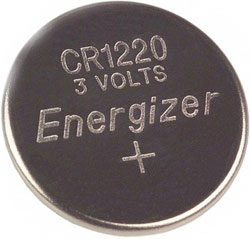
Carbon-monofluoride lithium battery labels start with 'B,' hence the label BR1220. The operating temperature of BR1220 batteries is usually in the range of -30°C (-22°F) and 85°C (185°F). The nominal voltage is 3.0 V, with a cutoff voltage of 2.0 V - very similar to the CR1220 battery. However, 'older' BR1220 batteries have a nominal voltage of 2.8 volts and a cutoff voltage of ~2.25 volts - regardless of the exact battery chemistry, BR1220 batteries have a more stable output voltage when compared with CR1220 batteries.
The typical capacity of the BR1220 battery is ~35 mAh. But, the standard discharge current is lower than the standard discharge current of CR1220 batteries and is ~0.03 mA, with the maximum allowed continuous discharge current of 0.1 (if allowed!).
On the other hand, BR1220 batteries feature a typical annual discharge rate of <1% (even less than that), thus having a shelf life of 10+ years, which may be very important for devices requiring reliable memory backup batteries.
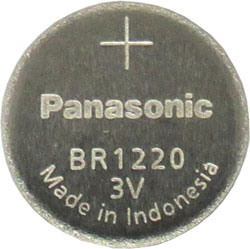
In most situations, BR1220 and CR1220 batteries are interchangeable for low-discharge applications.
For example, both batteries can be used for low-drain applications at room temperature, but for high-drain applications (for example, keyless LED flashlights, remote controls, and similar) CR1220 batteries are far better choices. On the other hand, for applications in extreme temperatures, BR1220 batteries are a better choice.
Also, as motherboard batteries, BR1220 batteries are a better choice since they have a lower self-discharge rate (<1% annually). However, there are also CR1220 batteries that feature a self-discharge rate as low as 1% per year - in that case, go for either BR1220 or a high-quality CR1220 battery - these are the batteries that cost a few dollars/euros at most, and there is really no point in saving few (euro)cents for the battery that is going to be used, perhaps, even for a decade.
Similarly, for watches that lack LED lights and audio alarms, BR1220 batteries may offer extra-long runtime (time between battery replacements) - again, high-quality CR1220 batteries can compare with BR1220 batteries in terms of shelf-life, but not in terms of operating temperature.
BR1220 and CR1220 Batteries Cross Reference Chart
The following comparison chart lists some of the most popular BR1220 and CR1220 batteries with their most important features and specifications (batteries are given in alphabetic order):
| Battery | Nominal Capacity | Operating Temperature Self-Discharge Rate |
Discharge Current |
| Duracell CR1220 | 38mAh over 45kΩ, down to 2.0V | -20°C to +60°C - |
0.1mA std. cont. 1.5mA max. cont. 5mA max. 1s pulse |
| Energizer CR1220 | 37mAh over 45kΩ, @21°C, down to 2.0V | -30°C to +70°C ~1% per year |
0.046mA std. cont. 2.8mA @2.8V 1kΩ 2s pulse |
| GP CR1220 | 38mAh over 30kΩ, @20±2°C, down to 2.0V | - - |
- |
| Maxell CR1220 | 36mAh | -20°C to +85°C - |
0.1mA std. cont. - |
| Panasonic BR1220 | 35mAh | -30°C to +85°C - |
0.03mA std. cont. |
| Panasonic CR1220 | 35mAh over 30kΩ, @20°C, down to 2.0V | -30°C to +85°C - |
0.095mA std. cont. |
| Renata CR1220 | 35mAh | -30°C to +85°C ~1% per year |
0.1mA std. cont. 1.0mA max. cont. |
| Varta CR1220 | 35mAh over 39kΩ, @20°C, down to 2.0V | -20°C to +70°C - |
- |
Lithium 3.0 volts non-rechargeable CR1220 batteries are very popular batteries manufactured by almost all most reputable battery brands, making these batteries rather easy to find, if not in the local hardware and office stores, then at online shops/stores.
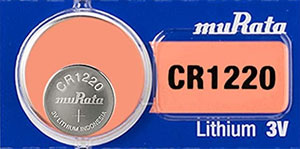
BR1220 and CR1220 Safety Issues
BR1220 and CR1220 batteries come in so-called 'pets-safe' and 'kids-safe' packages because, like all similar small and shiny objects (other button/coin cell batteries included), BR1220 and CR1220 batteries can be swallowed by kids and pets, and that can be very dangerous.
Although these batteries don't contain lead, cadmium, mercury, and other toxic heavy metals and similar pollutants, they are very dangerous when swallowed - they can cause chemical burns and physical damage to internal organs.
If these batteries (or any similar batteries) are swallowed, immediately contact the nearest emergency center (or doctor), explain what happened, and act according to their instructions.
CR1216 Batteries vs CR1220 Batteries vs CR1225 Batteries
CR1216, CR1220, and CR1225 batteries are very similar batteries, with the main difference being in size and, thus their features and performances:
- BR1216/CR1216 batteries feature physical dimensions of 12.5 x 1.6 mm, the smallest capacity (~25 mAh), and drain currents very similar to the BR1220/CR1220 batteries.
- BR1220/CR1220 batteries feature physical dimensions of 12.5 x 2.0 mm, smaller capacity (35-40 mAh), and somewhat lower drain currents than the BR1225/CR1225 batteries.
- BR1225/CR1225 batteries feature physical dimensions of 12.5 x 2.5, larger capacity (~50 mAh), and somewhat stronger discharge currents than the BR1220/CR1220 batteries.
Some battery compartments intended for BR1220/CR1220 batteries may accept larger BR1225/CR1225 batteries and/or smaller BR1216/CR1216 batteries; just be sure not to damage the device physically.
For example, some credit card size devices can get warped and change shape (and malfunction) due to the very small difference in the height of just 0.5 mm (that is ~0.02 inches!) between BR1220/CR1220 and BR1225/CR1225 batteries, while 0.4 mm difference between the height of BR1220/CR1220 and BR1216/CR1216 batteries can cause contact issues and unreliable operation.
In short, don't replace BR1220/CR1220 batteries with similarly sized button/coin cell batteries.
CR1216/BR1216 Batteries Environment Impact
CR1216/BR1216 batteries contain no heavy elements or toxic chemicals, but nonetheless, they should be recycled properly.
After the battery is discharged, take it to the nearest hardware or office supply store - they often collect similar batteries and send them to recycling facilities.
CR1216/BR1216 Batteries Safety Issues
There are two potential issues with CR1216/BR1216 batteries.
- Leakage: CR1216/BR1216 batteries generally don't leak and represent no danger for the powered device.
- Getting Swallowed: like all similar batteries, CR1216/BR1216 batteries are shiny objects that may attract kids and pets - be careful when working with CR1216/BR1216 batteries and keep kids and pets away. Should CR1216/BR1216 batteries get swallowed, contact the nearest emergency center (doc/vet), explain what happened, and follow their instructions.
How to Clean Leaked CR1220/BR1220 Battery
Cleaning up lithium manganese battery leakage requires caution due to the potentially hazardous materials involved. Here's a step-by-step guide to safely and effectively address the situation:
Ensure Safety: Before you begin, wear protective gear such as gloves and safety goggles. Ensure the area is well-ventilated to avoid inhaling any harmful fumes.
Remove the Battery: Carefully remove the battery from the device. If the device is still powered on, turn it off before proceeding. It's important to handle the battery gently to avoid further leakage or damage.
Dispose of the Battery Properly: Do not throw the leaked battery in regular trash due to the hazardous materials it contains. Check with your local waste management facilities for guidelines on disposing of lithium manganese batteries. They often require being taken to a special recycling or disposal center. Or check hardware or office supply stores to see if they collect old batteries like CR1220/BR1220.
Cleaning the Device:
- Neutralize the Leakage: Use a mild acid like white vinegar or lemon juice to neutralize the leakage from the battery. Apply it to the affected area using a cotton swab or a soft cloth, avoiding excessive wetting that could further damage the device.
- Clean the Residue: Once the leakage is neutralized, use a damp cloth to clean away any residue gently. If the leakage has dried, you might need to carefully scrape it off with a plastic scraper or a similar tool. Be careful not to damage the contacts or any parts of the device.
- Dry the Device: After cleaning, let the device dry completely before attempting to use or store it. This might take several hours, depending on the extent of the leakage and the cleaning process.
Check and Replace: Before inserting a new battery, inspect the device's battery compartment and contacts for any damage. If there is significant damage, it might be safer to consult a professional for repairs or consider replacing the device to avoid safety hazards.
Prevent Future Leaks: To prevent future leaks, ensure that you're using the correct battery type for your device, avoid mixing old and new batteries, and remove batteries from devices that won't be used for an extended period. Also, be sure to get batteries from reputable brands.
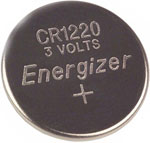 Long Story Short: BR1220 and CR1220 are very popular 12.5 x 2.0 mm lithium, non-rechargeable, 3.0-volt batteries.
Long Story Short: BR1220 and CR1220 are very popular 12.5 x 2.0 mm lithium, non-rechargeable, 3.0-volt batteries.
They can be found easily; just be sure to order the batteries from reputable brands that have many positive reviews - their batteries have already been tested in real-life situations by countless users.
Some of the most popular models include (Amazon links, the links open in the new windows):
In high-drain applications like keychain flashlights, car remote keys, remote controllers, and similar, CR1220 batteries are a much better choice than BR1220 batteries because of the high-drain currents.
When buying these or any other battery, be sure to order according to your own needs and requirements.

